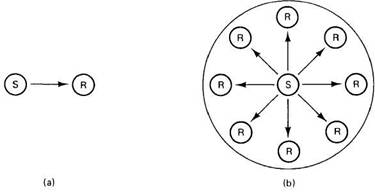Книга: Distributed operating systems
2.5.1. Introduction to Group Communication
2.5.1. Introduction to Group Communication
A group is a collection of processes that act together in some system or user-specified way. The key property that all groups have is that when a message is sent to the group itself, all members of the group receive it. It is a form of one-to-many communication (one sender, many receivers), and is contrasted with point-to-point communication in fig. 2-30.

Fig. 2-30. (a) Point-to-point communication is from one sender to one receiver. (b) One-to-many communication is from one sender to multiple receivers.
Groups are dynamic. New groups can be created and old groups can be destroyed. A process can join a group or leave one. A process can be a member of several groups at the same time. Consequently, mechanisms are needed for managing groups and group membership.
Groups are roughly analogous to social organizations. A person might be a member of a book club, a tennis club, and an environmental organization. On a particular day, he might receive mailings (messages) announcing a new birthday cake cookbook from the book club, the annual Mother's Day tennis tournament from the tennis club, and the start of a campaign to save the Southern groundhog from the environmental organization. At any moment, he is free to leave any or all of these groups, and possibly join other groups.
Although in this book we will study only operating system (i.e., process) groups, it is worth mentioning that other groups are also commonly encountered in computer systems. For example, on the USENET computer network, there are hundreds of news groups, each about a specific subject. When a person sends a message to a particular news group, all members of the group receive it, even if there are tens of thousands of them. These higher-level groups usually have looser rules about who is a member, what the exact semantics of message delivery are, and so on, than do operating system groups. In most cases, this looseness is not a problem.
The purpose of introducing groups is to allow processes to deal with collections of processes as a single abstraction. Thus a process can send a message to a group of servers without having to know how many there are or where they are, which may change from one call to the next.
How group communication is implemented depends to a large extent on the hardware. On some networks, it is possible to create a special network address (for example, indicated by setting one of the high-order bits to 1), to which multiple machines can listen. When a packet is sent to one of these addresses, it is automatically delivered to all machines listening to the address. This technique is called multicasting. Implementing groups using multicast is straightforward: just assign each group a different multicast address.
Networks that do not have multicasting sometimes still have broadcasting, which means that packets containing a certain address (e.g., 0) are delivered to all machines. Broadcasting can also be used to implement groups, but it is less efficient. Each machine receives each broadcast, so its software must check to see if the packet is intended for it. If not, the packet is discarded, but some time is wasted processing the interrupt. Nevertheless, it still takes only one packet to reach all the members of a group.
Finally, if neither multicasting nor broadcasting is available, group communication can still be implemented by having the sender transmit separate packets to each of the members of the group. For a group with n members, n packets are required, instead of one packet when either multicasting or broadcasting is used. Although less efficient, this implementation is still workable, especially if most groups are small. The sending of a message from a single sender to a single receiver is sometimes called unicasting (point-to-point transmission), to distinguish it from multicasting and broadcasting.




